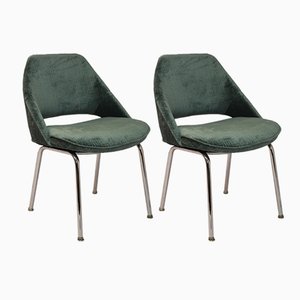
Manufacturer Wilde+Spieth was founded in 1831 as an Esslingen, Germany-based carpentry workshop, at first simply named Spieth. The company spent its initial century of activity producing roller shutters, before a 1948 collaboration with the esteemed German postwar architect and industrial designer Egon Eiermann redirected its range toward (and international renown). This fruitful partnership lasted until 1970 and produced over thirty chair designs that combined bentwood with tubular steel.
Standouts from Wilde+Spieth's timelessly modern collection include the three-legged SE 42 Chair (1949); the stackable SE 68 Desk Chair (1951); the E 10 Wicker Chair (1952); the SE 18 Folding Chair (1952), which was honored with a Good Design Award in 1953; the S 319 Folding Table (1952); and the SE 119 Church Chair (1958), which was designed to be used in St. Matthew’s Church in Pforzheim and was also used the same year in the dining room of the German Pavilion at the World’s Fair in Brussels.
Outside of Eiermann, Wilde+Spieth’s midcentury portfolio includes designs from other German modernist architects, most notably Paul Schneider von Esleben (and his ca. 1950s Rattan Chair with solid teak armrests); Herta-Maria Witzemann (and her 1954 Rattan Lounge Chair); and Ludwig Mies van der Rohe Bauhaus disciple, Herbert Hirche (and his ca. 1950s wicker Cane Chairs).
Since Eiermann’s passing in 1970, Wilde+Spieth has chiefly continued producing his most successful chair designs, revered as European modernist classics. In 2013, the company collaborated with contemporary maker Les Couleurs® to reissue Wilde+Spieth’s iconic SE 68 Desk Chair in four colors from the Le Corbusier color range, for which Les Couleurs has exclusive licensing. Orchestral seating, as well as , , and (i.e., instrumental floor pads and shelfs) round out the rest of company’s contemporary oeuvre—designs developed by talents that span from Daniel Libeskind to Thore Garbers and the collective Edelhoff & Nettesheim.


